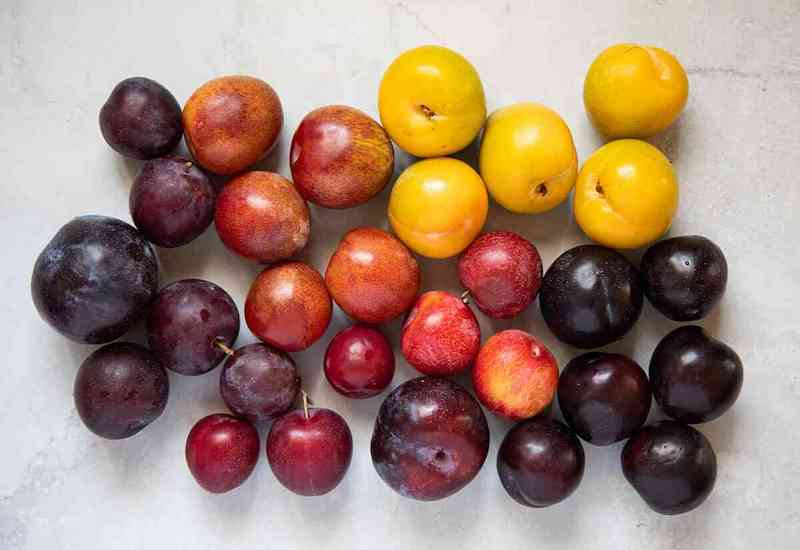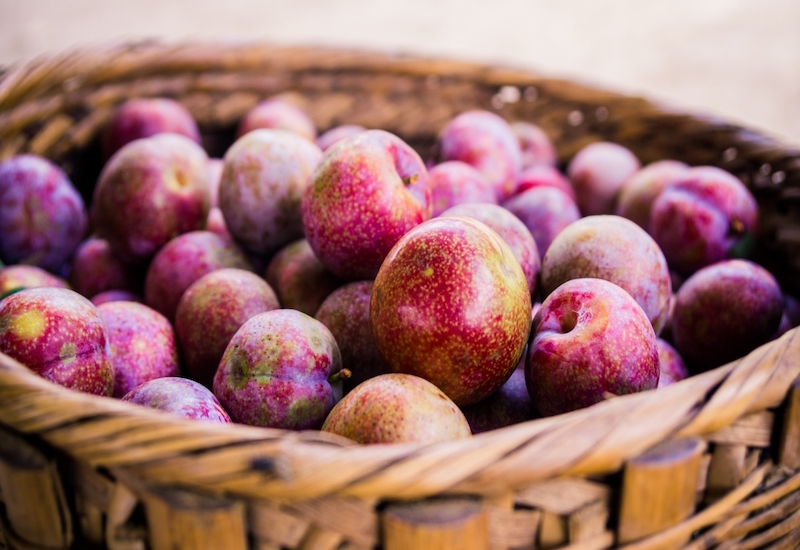Plums are one of the typical signs of summer. Not only a delicious fruit with many variations in processing and enjoying, plums are also highly appreciated by the medical community for their nutritional value to human health.
1. Morphological and growth characteristics of plum
Plums are also known as Mac man, Ly tu and originate from China. Since ancient times, plums have also appeared in many other territories such as Korea, Japan, Laos, India.
Currently, there are many different varieties of plums depending on the geographical location, terrain, and climate where plums are grown. However, the common characteristics of plum trees are:
Plum trees are woody plants, medium in size, with smooth, reddish-brown, short branches, and can grow up to 15m high. The bark of the tree is thorny, rough, grows straight and is divided into many small branches above.
The leaves grow alternately, lanceolate, each leaf is 6 – 8cm long, and about 3cm wide. The tip of the leaf blade is narrow and tapered, the base is prominent, the edges are serrated. Plum flowers have 5 petals growing in the leaf axils and are grouped in groups of 3-5, and are white. The plum fruit has an average diameter of about 5cm, is spherical, has a smooth outer shell with many different colors (red, blue, purple, yellow-green, purple,…) and contains a hard seed in the center.

There are many varieties of plums with different colors and sizes.
2. Plums and nutritional composition table
On average, 100g of plums will contain the following nutrients:
Water 94.1g, protein 0.6g, fat 0.2g, fiber 0.7g, glucid 3.9g;
- Energy: 20kcalo;
- Sugar: 9.92g including glucose, galactose, sucrose, fructose, …;
- Vitamins such as: vitamin B, C, E, K, …;
- Some essential minerals: iron 0.4mg, calcium 28mg, potassium 157mg, magnesium 7mg, zinc, manganese, copper, …;
- Other nutrients: beta carotene 96mcg, saturated and unsaturated fatty acids, purine 24mg, alanine, phenylalanine, lysine, valine, leucine, glutamic, aspartic acid,…
In particular, you should not eat plum seeds because the amygdalin contained in the seeds after we eat it will be broken down by amygdalinase and gastric acid into hydrocyanic acid. This substance inhibits the cytochrome oxidase enzyme, making people who eat it susceptible to respiratory disorders such as wheezing, shortness of breath,…
3. What are the effects of plums?
Plums help reduce blood fat, good for the heart:
Potassium contained in plums helps control blood pressure, stabilize heart rate and protect the cardiovascular system. In addition, plums contain very little fat and a lot of fiber, which also helps reduce cholesterol in the blood, limiting the risk of diseases such as anemia and myocardial infarction.
Obese and diabetic patients should eat plums because:
Plums have very few calories, but in return, they contain a lot of fiber, which helps slow down the absorption of fat and sugar from food, increasing insulin secretion. In addition, thanks to this process, blood sugar levels in the body are always maintained at a stable level, so plums are very suitable for people who are overweight, have dyslipidemia and diabetes.
Plums help prevent constipation and improve the digestive system:
The insoluble fiber of plums has the effect of preventing gastric juice and harmful bacteria from adversely affecting the stomach lining. In addition, it also helps us feel full for a long time, reduces appetite, stimulates digestion, promotes intestinal motility, and is a laxative.
Good for eyesight:
Vitamins and minerals such as vitamins A, B, C, beta carotene, … are all very good for eyesight and help prevent eye diseases such as cataracts, myopia, and macular degeneration.

Plums are highly valued by the medical community for their nutritional value.
Plums and their antioxidant and immune-boosting properties:
A plum can provide us with 7% of vitamin C, 8% of vitamin A with the function of enhancing resistance, anti-oxidation, increasing tissue connections and creating collagen. Thanks to that, it helps keep the skin smooth and reduces wrinkles.
Plums are also a fruit for pregnant mothers:
Thanks to their rich mineral and vitamin content, plums are very suitable for pregnant women because they help prevent uterine contractions, avoid anemia, the risk of premature birth, reduce stress, … in pregnant mothers.
Cancer prevention:
Anthocyanin pigments in plums help eliminate free radicals and are antioxidants, thereby helping to prevent some dangerous cancers such as prostate cancer, breast cancer, etc.
4. Important notes when using plums
As a fruit with high nutritional content, plums can be used dried or fresh depending on the purpose of use, such as eating fresh, dried, making jam, soft drinks, sauces, etc. However, eating too many plums is not best for people who are prone to internal heat or have special constitutions. If you consume too much of this fruit, it can lead to the following problems:
Affects tooth enamel, stomach, and acne due to internal heat;
Formation of kidney stones: plums contain a lot of oxalate – a substance that reduces the ability to absorb calcium and causes calcium deposits in the kidneys. This is considered the cause of kidney stones and urinary stones, so if you have or are suffering from kidney stones, you should limit your plum intake.

Eating too many plums can give you stomach upset and hot pimples.
Before using plums, you should wash the plums, then soak them in diluted salt water for about 30 minutes to remove pesticides and toxins on the fruit skin.
Plums are not only a familiar fruit that is popular every summer, but also a valuable medicine that is very beneficial to human health. However, you should only consume plums in moderation to avoid causing unwanted side effects!





